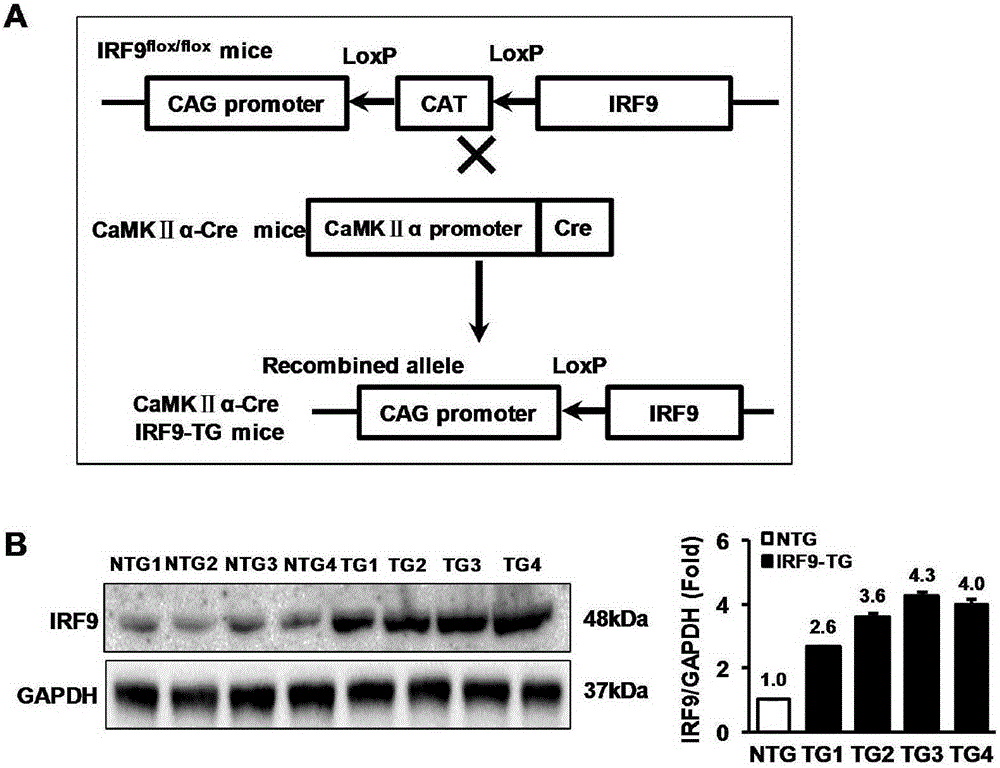Application of interferon regulatory factor 9 (irf9) and its inhibitors in stroke diseases
A technology of regulating factors and interferon, which is applied in the fields of nervous system diseases, cardiovascular system diseases, gene therapy, etc.
- Summary
- Abstract
- Description
- Claims
- Application Information
AI Technical Summary
Problems solved by technology
Method used
Image
Examples
Embodiment 1
[0034] [Example 1] Construction of nerve-specific IRF9 transgenic mice
[0035] The construction process of IRF9-flox mice:
[0036] Transgenic vector construction information: Use the upstream primer, namely 5'-CCAGATTACGCTGATATGGCATCAGGCAGGGCACG-3' (SEQ ID NO.1); the downstream primer, 5'-AGGGAAGATCTTGATTCAGCAGGCTCTACACAGGG-3' (SEQ ID NO.2), to amplify the full-length mouse IRF9 gene (NCBI, GeneID: 16391, NM_001159417.1), insert the cDNA into the pCAG-CAT-LacZ vector, which contains a CMV enhancer and a chicken β-actin gene (CAG, chicken β-actingene) promoter, and is connected to chloramphenicol Chloramphenicolacetyltransferase gene (CAT, chloramphenicolacetyltransferase), the loxP site is located on both sides of CAT, and the expression of IRF9 in nerve cells is driven by the CAG promoter ( figure 1 A). IRF9-floxed mice: The constructed pCAG-IRF9-CAT-LacZ vector was constructed into fertilized embryos (C57BL / 6J background) by microinjection to obtain IRF9-floxed mice. Ne...
Embodiment 2
[0039] [Example 2] Acquisition of mouse cerebral infarction model (I / R)
[0040] 1. Grouping of experimental animals: male C57BL / 6 strain wild-type mice, IRF9 knockout mice, brain-specific IRF9 transgenic mice and non-transgenic mice. Cerebral infarction models were established by middle cerebral artery ischemia-reperfusion (I / R). They were randomly divided into 8 groups with 10 mice in each group: C57BL / 6 strain wild-type mouse sham operation group (WTSHAM) and I / R operation group (WTI / R), IRF9 gene knockout mouse sham operation group (KOSHAM ) and I / R operation group (KOI / R), non-transgenic mouse sham operation group (NTGSHAM) and I / R operation group (NTGI / R), nerve cell-specific IRF9 transgenic mouse sham operation group (TGSHAM) and I / R surgery group (TGI / R).
[0041] 2. Suture embolization method for cerebral infarction I / R surgery adopts MCAO (middle cerebral artery occlusion, middle cerebral artery occlusion) model operation process:
[0042] (1) Grab the mouse, use...
Embodiment 3
[0047] [Example 3] Determination of Cerebral Infarction Volume in Cerebral Infarction Model (I / R) Mice
[0048] The evaluation indicators of the severity of cerebral ischemia / reperfusion injury mainly include cerebral infarct volume and neurological function score, and these indicators are positively correlated with the severity of ischemia / reperfusion injury.
[0049] (1) Neurological function and behavioral scores were performed 24h, 72h, and 7d after surgery before sampling;
[0050] Improved method based on Berderson neurological function score (9-point scale):
[0051] 0 points: no symptoms of nerve damage;
[0052] 1 point: The contralateral forelimb is curled up when the tail is raised, or the forelimb on the affected side cannot be fully reached;
[0053] 2 points: The opposite shoulder is adducted when the tail is raised;
[0054] 3 points: flat push: the resistance decreases when pushing to the opposite side;
[0055] 4 points: can move spontaneously in all direc...
PUM
 Login to View More
Login to View More Abstract
Description
Claims
Application Information
 Login to View More
Login to View More - R&D
- Intellectual Property
- Life Sciences
- Materials
- Tech Scout
- Unparalleled Data Quality
- Higher Quality Content
- 60% Fewer Hallucinations
Browse by: Latest US Patents, China's latest patents, Technical Efficacy Thesaurus, Application Domain, Technology Topic, Popular Technical Reports.
© 2025 PatSnap. All rights reserved.Legal|Privacy policy|Modern Slavery Act Transparency Statement|Sitemap|About US| Contact US: help@patsnap.com



